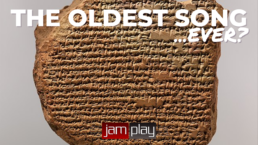The Oldest Song... Ever?
This week, as we head into Easter, millions of people across the U.S. will be gathering to celebrate this religious holiday. One celebratory activity that’s guaranteed to occur is the singing of religious songs. We call these hymns. And while that term may sound antiquated, it accurately describes the music you might sing in church today. But have you ever wondered about the origins of religious music? When did people first incorporate music into the worship of their deities? While we don’t know exactly the answer to that, we do have an idea of how old this tradition could be.
In the mid-20th century, archaeologists unearthed clay tablets inscribed with cuneiform writing and musical notation in the ancient city of Ugarit in present-day Syria. The tablet, which dates back to around 1400 BCE, contained the musical composition known as the Hurrian Hymn to Nikkal (a god in Hurrian civilization), or simply, “Hurrian Hymn No. 6.” The hymn was composed in the Hurrian language, an ancient language spoken in Mesopotamia. The tablet consists of 29 lines of text, with each line containing both cuneiform writing and musical notation.
But, that’s not all. The script used in the tablet is a form of diatonic notation, which means that the notes are arranged according to a fixed scale. Not only is this proof of the oldest written song, it’s also proof that the fixed scale is a way older invention than we previously thought (by about 900 or so years). You know what we still use today on guitars that we play? That’s right, the diatonic scale!
Let’s explore this oldest song and its elements to see what else it has in common with today’s music!
What does the oldest song sound like?
About 20 years after the tablets were discovered in Syria, a Californian Assyriologist named Anne Draffkorn Kilmer published an interpretation of the tablets as Western sheet music. Although no rhythm is implied in the texts, here is what that interpretation sounds like fundamentally (as performed on a MIDI instrument):
That was… nice. But, the tablets also contained texts that suggested tunings for a lyre – an early stringed instrument. Luckily, the acclaimed lyre player, Michael Levy reinterpreted the original transcription to create a solo lyre arrangement of his own. So, take a listen to how “Hymn No. 6” might have sounded when it was written:
Needless to say, the song is hauntingly beautiful. And, because it uses a 7-note, fixed scale like we do today, it’s easily replicable. It also means that it shares more in common with today’s music that one might expect. One significant similarity we can point out is the types of intervals used when harmonizing. Why is that important to us guitar players at JamPlay? Because those intervals help us create some of the most iconic guitar sounds we’re familiar with.
Major and Minor Thirds = Double Stops
As you can hear in both the MIDI rendition and Michael Levy’s arrangement of “Hymn No. 6,” there’s a decent amount of parallel thirds. When we use parallel thirds on the guitar, we often refer to them as “double stops.”
In this guitar lesson from D.J. Phillips, you can hear and see how double stops (sometimes major and minor thirds) can be applied to classic country music. For the full lesson with tab, plus more lessons like this, check out D.J. Phillips’ course on JamPlay.
Perfect Fifths = Power Chords
Another observation we can make about the harmony in “Hymn No. 6” is its use of perfect fifths. In the world of guitar, we use these commonly. They are the basis of power chords we use ubiquitously in rock music.
In this lesson, Callum Bair shows you how to turn a perfect fifth interval into a basic power chord. For the full lesson, and more lesson like this, check out Callum’s course on JamPlay!
Pedal Point = A Great Tool for Fingerstyle Guitar
Lastly, we can observe in “Hymn No. 6” that sometimes one note is played over and over, while a melody is played simultaneously. As mentioned in a previous blog, this is called “pedal point.” This can be a helpful technique to learn if you play fingerstyle, or are learning fingerstyle guitar. As we can hear, even in ancient times, this harmonic technique can result in some pretty sounding melodies.
For more Song Lessons, check out JamPlay.com! JamPlay has over 450 guitar courses from 120+ instructors, and online guitar lessons tailored to every skill level, music genre, and playing style. Click here to learn more.
Share this
Become a JamPlay member for unlimited access to 7000+ guitar lessons and 120+ artists and instructors. View membership plans ›



